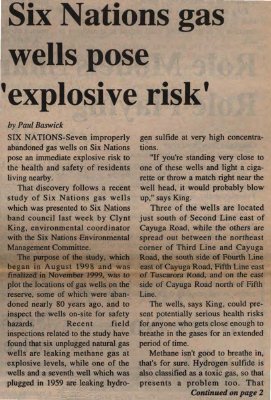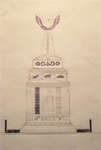"Six Nations gas wells pose 'explosive risk'"
- Publication
- Tekawennake News (Ohsweken, Ontario), 26 Apr 2000, pp.1-2
- Full Text
- Six Nations gas wells pose 'explosive risk'by Paul Baswick
SIX NATIONS - Seven improperly abandoned gas wells on Six Nations pose an immediate explosive risk to the health and safety of residents living nearby.
That discovery follows a recent study of Six Nations gas wells which was presented to Six Nations band council last week by Clynt King, environmental coordinator with the Six Nations Environmental Management Committee.
The purpose of the study, which began in August 1998 and was finalized in November 1999, was to plot the locations of gas wells on the reserve, some of which were abandoned nearly 80 years ago, and to inspect the wells on-site for safety hazards. Recent field inspections related to the study have found that six unplugged natural gas wells are leaking methane gas at explosive levels, while one of the wells and a seventh well which was plugged in 1959 are leaking hydrogen sulfide at very high concentrations.
"If you're standing very close to one of these wells and light a cigarette or throw a match right near the well head, it would probably blow up," says King.
Three of the wells are located just south of Second Line east of Cayuga Road, while the others are spread out between the northeast corner of Third Line and Cayuga Road, the south side of Fourth Line east of Cayuga Road, Fifth Line east of Tuscarora Road, and on the east side of Cayuga Road north of Fifth Line.
The wells, says King, could present potentially serious health risks for anyone who gets close enough to breathe in the gases for an extended period of time.
Methane isn't good to breathe in, that's for sure. Hydrogen sulfide is also classified as a toxic gas, so that presents a problem too. That
(Continued on page 2)
Six Nations gas wells pose 'explosive risk'(Continued from front page)
replaces the oxygen in the blood. You can breathe it in, plus it get absorbed right through your skin, so you wouldn't want to be around that too much."King says the cost of properly sealing the seven wells would run around $90,000 in total. The committee has requested funding from Indian and Northern Affairs Canada to plug the wells, but have so far been denied their requests for financial aid.
"They said based on their legal opinion, they do not have any liability with these wells, so they refused to provide funding to plug them. If an emergency situation does develop, they said they would help, but they don't consider this an emergency, I guess."
King says he doesn't know what INAC's definition of what an emergency is, but by his assessment, the condition of seven leaking wells should be considered as such.
"Once we measure explosive levels at the head of the gas wells, I would consider that an emergency situation. That's how we have presented it to Indian Affairs."
Without the support of INAC, adds King, the wells may continue to remain unsealed for the foreseeable future.
"That's about the only way we would be able to afford it. There are no other sources that we have been able to identify."
King says INAC's position is that property owners are responsible for maintenance or repair to the wells.
"Right now it's left up to the homeowner. Whoever owns the property is left with the liability in the opinion of Indian Affairs."
Until he is able to convince INAC to fund the proper abandonment of the wells, King says the committee and council are taking their own safety measures in the interim.
A three by five-foot map of the 255 abandoned wells uncovered during the committee's recent study will be hung in Six Nations Housing, to make homeowners aware if a well is located on their current property or on land they are considering purchasing. King says the committee will also push for policy that will ensure that new home owners are made aware if a well is on their property and what the safety risks are, although King says establishing that policy "could take a year."
In the meantime, King suggests anyone with a gas well on their property may want to consider identifying it as such as a safety precaution with signage or fencing.
While 255 wells were identified in the study, King adds there may be more in the area which have not yet been uncovered. Anyone finding what they believe to be an unmarked gas well is asked to contact the Environmental Committee at 445-0853.
- Creator
- Baswick, Paul, Author
- Media Type
- Text
- Newspaper
- Item Type
- Clippings
- Publisher
- Tekawennake News
- Place of Publication
- Six Nations of the Grand River, ON
- Date of Publication
- 26 Apr 2000
- Subject(s)
- Personal Name(s)
- King, Clynt.
- Corporate Name(s)
- Six Nations Elected Band Council ; Six Nations Environmental Management Committee ; Indian and Northern Affairs Canada ; Six Nations Housing.
- Local identifier
- SNPL004845v00d
- Language of Item
- English
- Geographic Coverage
-
-
Ontario, Canada
Latitude: 43.06681 Longitude: -80.11635
-
- Creative Commons licence
 [more details]
[more details]- Copyright Statement
- Public domain: Copyright has expired according to Canadian law. No restrictions on use.
- Copyright Date
- 2000
- Copyright Holder
- Tekawennake News
- Contact
- Six Nations Public LibraryEmail:info@snpl.ca
Website:
Agency street/mail address:1679 Chiefswood Rd
PO Box 149
Ohsweken, ON N0A 1M0
519-445-2954



